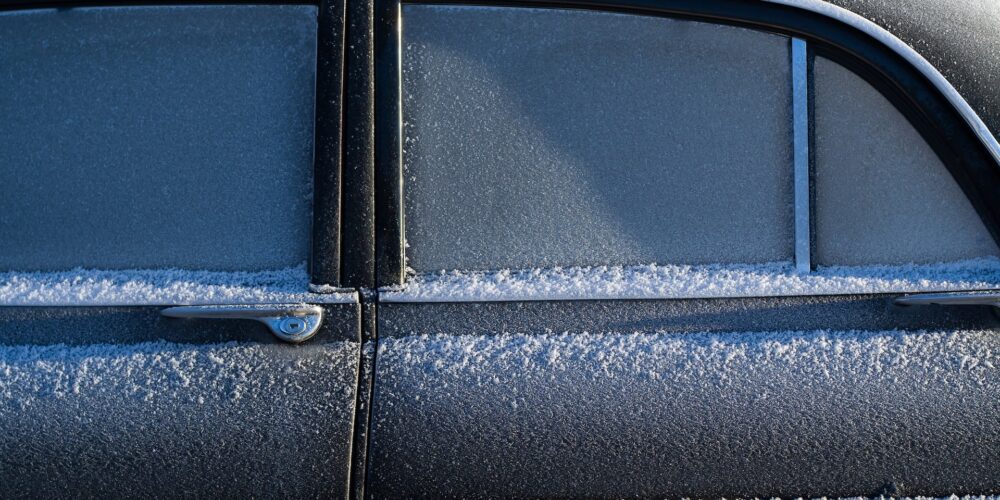Winter is well and truly upon us and now that all of the festivities of the holidays are over, there is still one longstanding debate that doesn’t have a clear answer – of all the tips, tricks and hacks around, what is the best way to defrost your windows when the weather’s turned icy? Whether it’s a light layer of frost that can be scraped with ease, or you’re fighting with thick ice that requires more effort than you might be willing to give on a freezing weekday morning, there are some interesting hacks out there to make the process easier. From the smart and handy, to the outright dangerous, we’ve compiled some of the most common defrosting solutions to find out which is actually the best.
DON’T: Use hot or cold water
While this should arguably be common knowledge, not everyone realises just how damaging using hot or cold water on a frozen windscreen could be. Boiling or very hot water can create such a sharp contrast in temperatures that the glass could crack or even break completely under a sudden change. Cold water, on the other hand, might seem to clear the ice initially but it’s more likely to re-freeze over your existing problem and create an even more stubborn one. If you are in a pinch, lukewarm water in a bag gently rolled could help but even this risks damage to your windscreen if the temperature difference is too great.
DO: Use Your Car’s Heater
When things are icy outside, make sure you go out a little earlier than you usually would to give your car time to warm up. Not only will the windscreen and windows be icy, but the inside of your car could also be frosty or need some extra time to get running properly. Your best bet is to turn the car on, set the heaters running full on your windscreen and rear window, and then stay with it while it runs. You can use the time it’ll take to warm things up brushing off snow or scraping off as much ice as you can.
DON’T: Try and use your windscreen wipers
Before you even start up your car, you should check that your wipers aren’t on and that they aren’t stuck to the windscreen. If you try and use your windscreen wipers while they are stuck, it could lead to a breakage in the motor or damage to the wipers themselves. Similarly, trying to wipe hard ice off of your windscreen can cause damage to the rubber and leave streaks and smears when you need them most. Only use your wipers once your windscreen is clear or the ice has been melted.
DO: Use An Ice Scraper
Ice scrapers come in all shapes, sizes and varieties and are often inexpensive, making them the perfect often fool-proof tool for clearing your windscreen. Sure, it takes time to scrape every inch of your windscreen and it can be a workout you might not want in sub-zero temperatures in the morning, but taking the time to scrape your windscreen fully can make de-misting the inside much faster and ensure you can get out on the road safely. You can pair ice scrapers with a de-icer fluid to make the process easier if the ice is particularly stubborn.
DON’T: Use Road Salt
While a diluted salt-water solution can be used as a quick fix in a pinch, using salt on your car should be avoided where possible. It might be good for the roads, but salt build-up on your car could lead to advanced corrosion and damage in the long term. If you do use a salt solution, you can wash away the salt water with lukewarm water once your car has warmed up a bit.
DO: Use De-Icer
De-icers exist for a reason and whether you make your own or buy one from a store, they can be miracle workers when things get frosty. While de-icers have been known to harm paintwork in the past, modern solutions are designed to cause no damage though to be safe, you should avoid using them anywhere but on your windows. The chemicals could mix poorly with coolant and oil reservoirs if it seeps in, causing damage to the interior of your vehicle’s components.
The Verdict?
When it comes to defrosting solutions, there are plenty out there but the best in our opinion is as simple as starting up your car, getting the heater on and using a bit of elbow grease to scrape off what you can. De-icers can help speed up the process in a rush or when facing stubborn, thick ice, but aren’t always necessary. Most importantly, you should always make sure you’re accounting for extra time before you get going in the mornings or when heading out onto the roads. You should never rush off your driveway or out of your parking space with a half-cleared window or a misty interior windscreen. Taking the extra minutes to let your engine warm up will not only mean you can drive safely, but it gives your car a chance to get running properly too, making for a smoother drive overall.
If you have any other questions about caring for your car this winter, or if your car’s been damaged by some ill-given defrosting advice, we’re on hand to help. Simply get in touch with our team and we’ll book you and your car in at your nearest Service4Service garage.

